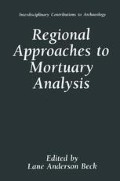Abstract
There can be little question that the publication of SAA Memoir number 25, Approaches to the Social Dimensions of Mortuary Practices (Brown 1971), represented a major turning point in the way archaeologists view funerary remains. Prior to this time, the analysis of cemeteries tended to be the domain of the “sensitive” (those who sought a transcendental “nearness” to past societies through their dead) and the taxonomist, who sought to build chronologies through the seriation of grave lots. The promise of that (now far off) symposium was not just the potential to “dig up a kinship system” (Binford 1972:8), but the possibility that the unique kinds of evidence present in funerary contexts could provide the basis for a truly anthropological archaeology.
Access this chapter
Tax calculation will be finalised at checkout
Purchases are for personal use only
Preview
Unable to display preview. Download preview PDF.
References
Banner, J., 1928, Az öszentiváni ásatások, Dolgozatok Szeged IV(1-2):148–237.
Banner, J., 1929, Az öszentiváni bronzkori telep és temetö, Dolgozatok Szeged V (1-2):52–78.
Banner, J., 1931, A Marosvidék bronzkori zsugoritott temetkezéseinek sirmellékletei, Dolgozatok Szeged VII:7–53.
Bátora, J., 1990, The latest knowledge on the burial rite of the people of the Nitra Group, Anthropologie XXVIII /2-3:169–174.
Binford, L., 1972, An Archaeological Perspective, Seminar Press, New York.
Bognár-Kutzián, I., 1963, The Copper Age Cemetery of Tiszapolgár-Basatanya, Akadémiai Kiadö, Budapest.
Bognár-Kutzián, I., 1972, The Early Copper Age Tiszapolgár Culture, Akadémiai Kiadö, Budapest.
Bona, I., 1965, The peoples of southern origin of the Early Bronze Age in Hungary, I. The Pitvaros Group, Alba Regia 4-5:17–63.
Bona, I., 1975, Die mittlere Bronzezeit Ungarns und ihre südöstlichen Beziehungen, Akadémiai Kiadö, Budapest.
Bradley, R., 1981, “Various styles of urns”—Cemeteries and settlement in southern England c. 1400-1000 bc, in: The Archaeology of Death (R. Chapman, I. Kinnes, and K. Randsborg, eds.), Cambridge University Press, Cambridge, pp. 93–104.
Brown, J. (ed.), 1971, Approaches to the Social Dimensions of Mortuary Practices, Society for American Archaeology, Memoir 25.
Chapman, J., 1983, Meaning and illusion in the study of burial in Balkan prehistory, in: Ancient Bulgaria (A. Poulter, ed.), University of Nottingham Department of Classical and Archaeological Studies, 1:1-42.
Chapman, R., 1981, The emergence of formal disposal areas and the “problem” of megalithic tombs in prehistoric Europe, in: The Archaeology of Death (R. Chapman, I. Kinnes, and K. Randsborg, eds.), Cambridge University Press, Cambridge, pp. 71–81.
Deetz, J., and E. Dethlefsen, 1971, Some social aspects of New England colonial mortuary art, in: Approaches to the Social Dimensions of Mortuary Practices (J. Brown, ed.), Society for American Archaeology, Memoir 25, pp. 30–38.
Farkas, G., and P. Liptak, 1971, Physical anthropological examination of a cemetery in Mokrin from the Early Bronze Age, in: Mokrin, The Early Bronze Age Necropolis, vol. 1 (M. Giric, ed.), Dissertationes et Monographiae XI:239-271.
Foltiny I., 1941a, A szöregi bronzkori temetö, Dolgozatok Szeged 17:1–89.
Foltiny, I., 1941b, Koraréz-es bronzkori temetö Deszken, Folia Archaeologa 3-4:69–98.
Foltiny, I., 1942, A “Deszk-F” bronzkori temetö, A Szegedi Városi Múzeum Kiadványai II(3):9–30.
Gazdapusztai, A., 1968, Das Bronzezeitliche gräberfeld von Battonya, Acta Antiqua et Archaeologica, Szeged 12:5–37.
Giric, M. (ed.), 1971, Mokrin, the Early Bronze Age Necropolis, vol. 1, Dissertationes et Monographiae XI.
Goldstein, L., 1976, Spatial Structure and Social Organization: Regional Manifestations of Mississippian Society, Unpublished Ph.D. dissertation, Northwestern University, Evanston, Illinois.
Horvath, E, 1982, Contributions to the Early and Middle Bronze Age of the Southern Alföld, A Mãra Ferenc Múzeum Évkönyve 83(1):55–71.
Kalicz, N., 1968, Die Frühbronzezeit in Nordostungarn, Archaeologica Hungarica 45, Akadémiai Kiadö, Budapest.
Lengyel, I., 1972, Laboratory analysis of the human bone finds from the Early Bronze Age cemetery of Mokrin, in: Mokrin, The Early Bronze Age Necropolis, vol. 2 (N. Tasic, ed.), Dissertationes et Monografiae XII:75-90.
Metcalf, P, 1981, Meaning and materialism. The ritual economy of death, Man 16:563–578.
Morris, I., 1987, Burial and Ancient Society, Cambridge University Press, Cambridge.
O’Shea, J., 1984, Mortuary Variability: An Archaeological Investigation, Academic Press, Orlando.
O’Shea, J., 1991, A radio-carbon based chronology for the Maros Group of Southeast Hungary, Antiquity 65:97–102.
O’Shea, J., n.d., Report on excavations at Klarafalva-Hajdova and Kiszombor Új Élet, manuscript in preparation.
O’Shea, J., and J. Ludwickson, 1992, Archaeology and Ethnohistory of the Omaha Indians: The Big Village Site, University of Nebraska Press, Lincoln.
Pebbles, C., 1971, Moundville and surrounding sites: Some structural considerations of mortuary practices, II, in: Approaches to the Social Dimensions of Mortuary Practices (J. Brown, ed.), Society for American Archaeology, Memoir 25, pp. 68–91.
Primas, M., 1977, Untersuchungen zu den Besttattungssitten der ausgehenden Kupfer und frühen Bronzezeit, Bericht der Römisch-Germanischen Kommission 58:1–160.
Randsborg, K., 1974, Social stratification in Early Bronze Age Denmark, Praehistoriche Zeitschrift 49:38–61.
Roymans, N., 1990, Tribal Societies in Northern Gaul. An Anthropological Perspective, University of Amsterdam, Albert Eggen van Giffen Institute voor Praeen Proto History, Cingula 12.
Sandor-Chicideanu, M., and I. Chicideanu, 1989, Zu den gräbsitten der Periam-Pecica Kultur, Dacia XXXIII(1-2):5–38.
Tainter, J., and R. Cordy 1977, An archaeological analysis of social ranking and residence groups in prehistoric Hawaii, World Archaeology 9(1):95–112.
Tasic, N., 1972, The Mokrin necropolis and its position in the development of the Early Bronze Age in Voivodina, in: Mokrin, The Early Bronze Age Necropolis, vol. 2 (N. Tasić, ed.), Dissertationes et Monografiae XII:9-28.
Trogmayer, O., 1975, Das Bronzezeitliche gräberfeld bei Tápé, Fontes Archaeologici Hungariae, Akadémiai Kiadö, Budapest.
Author information
Authors and Affiliations
Editor information
Editors and Affiliations
Rights and permissions
Copyright information
© 1995 Springer Science+Business Media New York
About this chapter
Cite this chapter
O’Shea, J.M. (1995). Mortuary Custom in the Bronze Age of Southeastern Hungary. In: Beck, L.A. (eds) Regional Approaches to Mortuary Analysis. Interdisciplinary Contributions to Archaeology. Springer, Boston, MA. https://doi.org/10.1007/978-1-4899-1310-4_6
Download citation
DOI: https://doi.org/10.1007/978-1-4899-1310-4_6
Publisher Name: Springer, Boston, MA
Print ISBN: 978-1-4899-1312-8
Online ISBN: 978-1-4899-1310-4
eBook Packages: Springer Book Archive

